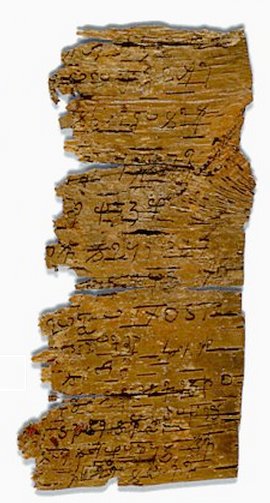
In 1994, the British Library obtained several decaying birch-bark scrolls with writing in an ancient Gandharan script. They contained a variety of Buddhist texts, and were dated back to the middle of the first century — to about the year 50 C.E. Though no one knows exactly where and how they were found, the evidence points to these texts having been buried in clay pots, probably in lieu of throwing them away, after they had been recopied for a library in what is now far eastern Afghanistan, somewhere around the area between Jalalabad and Peshawar, in what was a thriving and cultured area known as Gandhara. The texts are still partly readable, and cover a range of Buddhist works, and include a sutta (AN 4.36) recently discussed, in the post “I Am Not A Man.”
The story as laid out on the Gandharan scrolls is not letter-for-letter the same, or word-for-word, or even phrase-for-phrase. The vocabulary is quite similar, spelling is somewhat modified — and there are small bits missing, as well as the traditional opening lines. The book “Three Gāndhārī Ekottarikāgama-type sūtras: British Library Kharoṣṭhī” has a thorough reconstruction that can be examined through Google Books, but below I offer a somewhat smoothed version that should be enough to let us look at the differences between the readily-available Pali version, and the older Gandharan.
*~*~*
The Bhagavat, traveling between cities, stepped off the road. Seating himself near the root of a tree, he spent the day.
At about the same time a brahmin named Dhona had started out on the same road. Dhona noticed the wheel-marks on the footprints of the Bhagavat on the road before him, thousand-spoked, with all parts complete, sharp, resplendent. Following the footprints of the Bhagavat, he saw him who had traveled on the road. He had stepped off the road and sat near the root of a tree. His appearance was fair, pleasing, his faculties calm, his mind calm, having attained the highest training and calm. . . a protector, trained, controlled, with faculties restrained, like a clear, translucent, serene pond.
Having seen him, he approached the Bhagavat. Having approached, he said this to the Bhagavat.
“Venerable sir, will you be (bhaviśasi) a deva?”
“Brahmin, I will not be (bhaviśe) a deva.”
“Venerable sir, will you be a gandharva?”
“Brahmin, I will not be a gandharva.”
“Venerable sir, will you be a yaksa?”
“Brahmin, I will not be a yaksa.”
“Sir, will you be (bhaviśasi) a human (maṇosu)?”
“Brahmin, I will not be (bhaviśe) a human.”
“Being asked thus, ‘Sir, will you be a deva?’ you say this, ‘Brahmin, I will not be a deva.’ Being asked thus, ‘Sir, will you be a gandharva?’ you say this, ‘Brahman, I will not be a gandharva.’ Being asked thus, ‘Sir, will you be a yaksa?’ you say this, ‘Brahmin, I will not be a yaksa.’ Being asked thus, ‘Sir, will you be a human?’ you say this, ‘Brahman, I will not be a human.’ Who, then, sir, will you be?” (ku re bhu bhaviśasi)
“Brahmin, I am the Awakened One. I am the Awakened One.” (budho mi brahmaṇa budho mi)
*~*~*
The core story is very much the same as the Pali version. The opening lines and the ending of the sutta, however, are quite different. Read the rest of this entry »